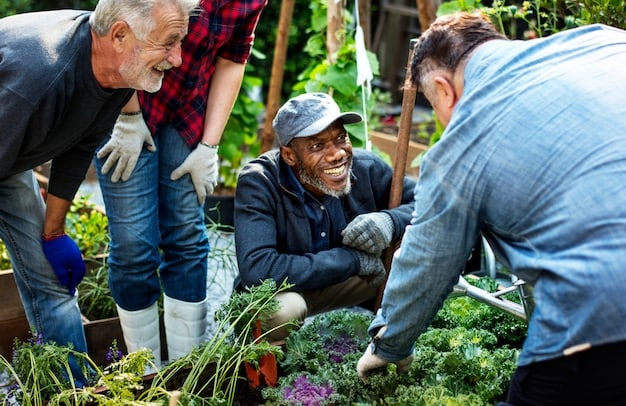Combatting Loneliness: Social Strategies for Men in the US

Combatting Loneliness and Isolation: Practical Strategies for Improving Social Connections for Men in the US involves understanding the root causes of isolation and actively engaging in strategies that foster meaningful social bonds. This approach includes seeking support, exploring hobbies, and building stronger community ties.
Loneliness and isolation are significant challenges affecting men across the United States. Combatting Loneliness and Isolation: Practical Strategies for Improving Social Connections for Men in the US requires a proactive approach, focusing on understanding the underlying causes and implementing actionable strategies. This article delves into effective methods to help men foster meaningful connections and improve their overall well-being.
Understanding Loneliness and Isolation in Men
Loneliness is a complex emotion often stemming from a perceived gap between desired and actual social connections. For men, societal expectations and traditional gender roles can exacerbate feelings of isolation, making it challenging to seek help or express vulnerability.
Factors Contributing to Male Isolation
Several factors can contribute to loneliness and isolation in men. Understanding these elements is a crucial first step in addressing the issue effectively.
- Societal Expectations: Men are often conditioned to be self-reliant and stoic, which can discourage seeking help or admitting to feelings of loneliness.
- Work-Life Imbalance: Demanding work schedules and career pressures may leave little time for nurturing social connections.
- Geographic Mobility: Frequent relocation for career opportunities can disrupt established relationships and create a sense of displacement.
- Life Transitions: Events such as retirement, divorce, or the loss of a loved one can trigger or worsen feelings of isolation.
Men who experience these factors may find it difficult to maintain social bonds, leading to increased loneliness. Addressing these underlying issues is essential for combatting loneliness and isolation effectively.

Understanding the diverse factors contributing to isolation allows for tailored strategies to combat loneliness. Addressing these root causes is key in ensuring a sustainable improvement in social connections for men in the US.
Building a Supportive Network
One of the most effective ways to combat loneliness is by building and nurturing a supportive social network. This involves actively engaging in social activities and consciously developing meaningful relationships.
Joining Groups and Clubs
Joining groups or clubs centered around shared interests provides opportunities to meet like-minded individuals and form new connections. This can range from sports teams to book clubs to volunteer organizations.
- Sports and Recreation: Participating in team sports, hiking groups, or cycling clubs can foster camaraderie and provide a sense of belonging.
- Hobby-Based Clubs: Joining a book club, photography group, or woodworking club allows you to connect with others who share your passions.
- Volunteer Organizations: Volunteering for a cause you care about not only benefits the community but also provides opportunities to meet compassionate and dedicated individuals.
Engaging in these activities can help to improve social connections and reduce feelings of loneliness. Shared experiences create bonds and offer a sense of purpose.
Developing a supportive network requires consistent effort. Actively participate in group activities, initiate conversations, and follow up with individuals you connect with.

Practical Communication and Social Skills
Improving communication and social skills are crucial elements for combatting loneliness and isolation, enabling men to initiate and maintain meaningful relationships.
Initiating Conversations
Starting a conversation can be daunting, but mastering a few simple techniques can make it easier to connect with others. Approachability and openness are key factors.
- Use Open-Ended Questions: Instead of asking simple yes/no questions, ask questions that invite the other person to share more about themselves. For example, “What do you enjoy most about this event?” rather than “Are you having a good time?”
- Active Listening: Pay attention to what the other person is saying, nod to show you’re engaged, and ask follow-up questions to demonstrate your interest.
- Find Common Ground: Look for shared interests or experiences to establish a connection. This could be as simple as commenting on the venue or the weather.
Consistent practice can boost confidence and improve these skills over time. Men can use these techniques to improve social connections.
Effective communication is an essential component of building lasting relationships. By practicing these strategies, men can feel more empowered to connect with others and reduce their feelings of isolation.
Embracing Vulnerability and Seeking Support
Overcoming the societal expectations that discourage men from expressing vulnerability is crucial for combatting loneliness and isolation. Seeking support from friends, family, or professionals can significantly improve mental and emotional well-being.
The Importance of Emotional Expression
Expressing emotions and vulnerabilities allows for deeper connections and understanding. Challenging traditional views on masculinity can foster a more open and supportive environment.
- Challenge Societal Norms: Understand that expressing emotions is a sign of strength, not weakness.
- Practice Self-Compassion: Be kind to yourself and acknowledge your feelings without judgment.
- Share Your Experiences: Open up to trusted friends or family members about your feelings and challenges.
By embracing vulnerability, men can create stronger, more authentic relationships, reducing feelings of loneliness. This approach also sets a positive example for others, encouraging them to seek support when needed.
Allowing yourself to be vulnerable can lead to building deeper connections. Men can use these techniques to improve social connections.
Leveraging Technology for Connection
In today’s digital age, technology can be a valuable tool for combatting loneliness and isolation. Online platforms and social media can help men connect with others who share their interests or experiences.
Joining Online Communities
Participating in online forums, social media groups, or gaming communities can provide a sense of belonging and connection, particularly for those who may find it challenging to connect in person.
- Find Interest-Based Groups: Look for online communities centered around your hobbies, interests, or professional field.
- Engage Actively: Participate in discussions, share your experiences, and offer support to other members.
- Be Mindful of Boundaries: While online connections can be valuable, it’s important to maintain healthy boundaries and prioritize real-life interactions.
Combatting loneliness and isolation can be more achievable through technology. These platforms offer diverse avenues for engagement and social interaction.
Technology can complement real-life efforts to build connections, but should not replace them entirely. The goal is to use digital tools to enhance rather than substitute meaningful relationships.
| Key Point | Brief Description |
|---|---|
| 🤝 Building Networks | Joining groups can foster connections. |
| 🗣️ Improve Skills | Enhance communication for deeper bonds. |
| ❤️ Embrace Support | Seek help and show vulnerability. |
Frequently Asked Questions
Practical strategies for combatting loneliness and isolation among men include joining hobby groups, volunteering in the community, and seeking professional counseling or support groups to address underlying issues.
Social media platforms can help connect with like-minded individuals through interest-based groups, but it’s important to balance online interaction with real-life relationships for genuine connections.
Societal expectations often pressure men to be stoic and self-reliant, which can discourage expressing vulnerability or seeking help for feelings of loneliness and isolation. Combatting Loneliness and Isolation requires challenging these norms.
Men’s support groups provide a safe space to share experiences, gain emotional support, and learn coping strategies. This environment fosters connection and reduces feelings of isolation.
Reflecting on life transitions, career pressures, and societal expectations can help identify causes of loneliness. Seeking therapy or counseling can provide strategies for combatting loneliness and isolation effectively.
Conclusion
Combatting Loneliness and Isolation: Practical Strategies for Improving Social Connections for Men in the US requires proactive effort and a willingness to challenge societal norms. By building supportive networks, enhancing communication skills, and embracing vulnerability, men can foster meaningful connections and improve their overall well-being.





